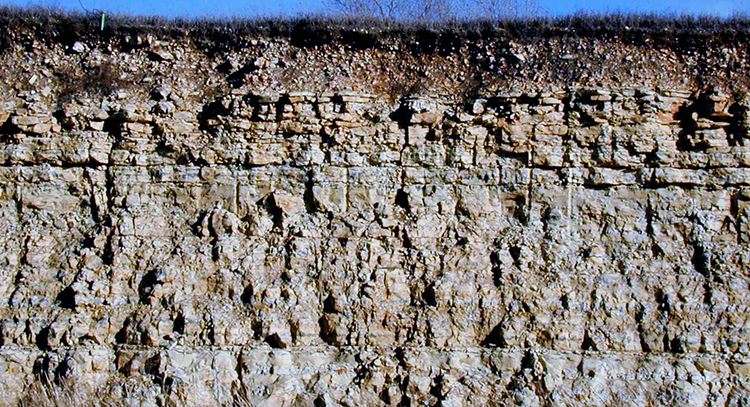Limestone

One of the most common rocks in Kansas, limestone is a sedimentary rock composed mainly of the mineral calcite, which is a calcium carbonate. Most limestone layers formed from marine sediment deposited on sea floors, although some formed in freshwater lakes and rivers and even on dry land. Sources for the calcite in limestone include seashells. When shelled animals that use calcium carbonate in water to build their shells die, the remains of their shells accumulate on a sea or lake floor. Under the right conditions, large amounts of shell debris eventually gets buried under other sediment and compressed into rock. Many limestone layers also contain fossils of such animals as corals, brachiopods, clams, bryozoans, crinoids, and one-celled fusulinids that were preserved whole or nearly whole.
Different types of material form different types limestone. Chalk, for example, is a type of limestone made up mainly of the remains of microorganisms and algae. Pure limestone is white or almost white. Layers of limestone, however, often contain sand, organic remains, iron oxide, and other impurities that turn them a variety of colors from yellow to gray to red.
Limestone is most common in eastern Kansas, the Flint Hills, and the central portion of the Smoky Hills.
Limestone is used as a construction material in buildings and, historically, in bridges. It also is used to make cement, in the construction of roads, as railroad ballast, and in fertilizer.
Resources
Buchanan, R., 2010, Kansas Geology: An Introduction to Landscapes, Rocks, Minerals, and Fossils (2nd ed.): Lawrence, Kansas, University Press of Kansas, 240 p.
Buchanan, R., and McCauley, J. R., 2010, Roadside Kansas: A Traveler's Guide to Its Geology and Landmarks (2nd ed.): Lawrence, Kansas, University Press of Kansas, 392 p.
Kansas Rocks and Minerals, Kansas Geological Survey Educational Series 2